MAKING SENSE - CONSTRUCTING KNOWLEDGE |
| |
| Manifesting the research process - visual-, and sculptural research approaches. Relations between the visual arts, design, architecture and natural sciences. |
| |
RESEARCH EXHIBITION 2005
Constructing Knowledge - Models and Model-Building in Chemistry
Konstruktion von Wissen - Modelle und Modellbau in der Chemie Exhibition at the Akademie Schloss Solitude May 13 - June 25, 2005
Curater: Anke Zürn |

Exhibition view “Constructing Knowledge - Models and Model-Building in Chemistry”, Akademie Schloss Solitude Stutgart, May 13 - June 25, 2005. Photographs: Anke Zürn & Tatsuto Suzuki
|
| |
Introduction:
How to investigate and how to communicate what can not be seen directly with the human eye?
This fundamental question consequently led chemists to develop their own (visual) languages and symbols. Complicated and not directly observable processes and systems are represented visually with extreme reduction and high abstraction. Thus models and specific visual symbols (chemical formulas), schematic representations and simulations have their long tradition and are essential for communicating chemistry.
The knowledge of a systems topology, such as the arrangement of atoms in a crystal structure, is crucial for doing research on crystalline materials. Hereby the construction of “real” 3D models of crystal structures seems to play an important role. It allows a) for working out the system’s specific topology, and b) for the understanding and the communication there of. Different visualization and representation types encode different chemical and physical properties.
Also today, where computer based scientific visualization and virtual generated models became standard in chemists’ research labs, the construction of “real” models still has its place in everyday research.
Within the exhibition "Constructing Knowledge - Models and Model-Building in Chemistry" at Akademie Schloss Solitude (Stuttgart), concrete examples from chemistry, crystallography and materials sciences where used to investigate the significance of model and the model-building itself, as well as the different (visual) representation strategies, and the media’s possibilities. The focus was on models and model building during the research process. |
|
Einführung:
Wie untersuchen, was dem menschlichen Auge nicht direkt zugänglich ist und wie kommunizieren, was nicht direkt sichtbar ist?
Diese zentrale Frage führte die Chemie in konsequenter Weise zur Entwicklung einer eigenen (visuellen) Sprache und Symbolik, um in extremer Reduktion und hoher Abstraktion komplizierte, nicht direkt beobachtbare Prozesse und Systeme modellhaft repräsentieren zu können. Modelle, spezifische visuelle Symbole (chemische Formeln), schematische Darstellungen und Simulationen haben eine lange Tradition und sind essentieller Bestandteil der Kommunikation chemischer Inhalte. So ist Beispielsweise die Kenntnis der Topologie eines Systems, wie die räumliche Anordnung von Atomen in einem Kristall, wichtige Voraussetzung für nachfolgende Untersuchungen. Dabei scheint der Konstruktion “realer” dreidimensionaler Kristallstrukturmodelle eine besondere Rolle zuzukommen. Topologische Besonderheiten werden oft erst durch den Modellbau selbst herausgearbeitet, und damit erfassbar, untersuchbar und kommunizierbar gemacht, wobei je nach Darstellungsweise unterschiedliche Wechselwirkungen und Eigenschaften kodiert werden können. Auch heute, da Computer basierte wissenschaftliche Visualisierungsprogramme und virtuelle Modelle längst zum Standard geworden sind, hat der Modellbau einen selbstverständlichen Platz im Forschungsalltag.
In der Ausstellung "Konstruktion von Wissen - Modelle und Modellbau in der Chemie" an der Akademie Schloss Solitude (Stuttgart) wurde an Hand konkreter Beispiele aus der Chemie, der Kristallographie und den Materialwissenschaften wurde die Bedeutung von Modellen und des Modellbaus für die Forschung untersucht, unterschiedliche Darstellungsstrategien wurden herausgearbeiten, und Möglichkeiten und Grenzen der eingesetzten Medien hinterfragen. |
| |
|
|
Models for Communicating Chemistry / Modelle zur Kommunikation chemischer Inhalte |
| |
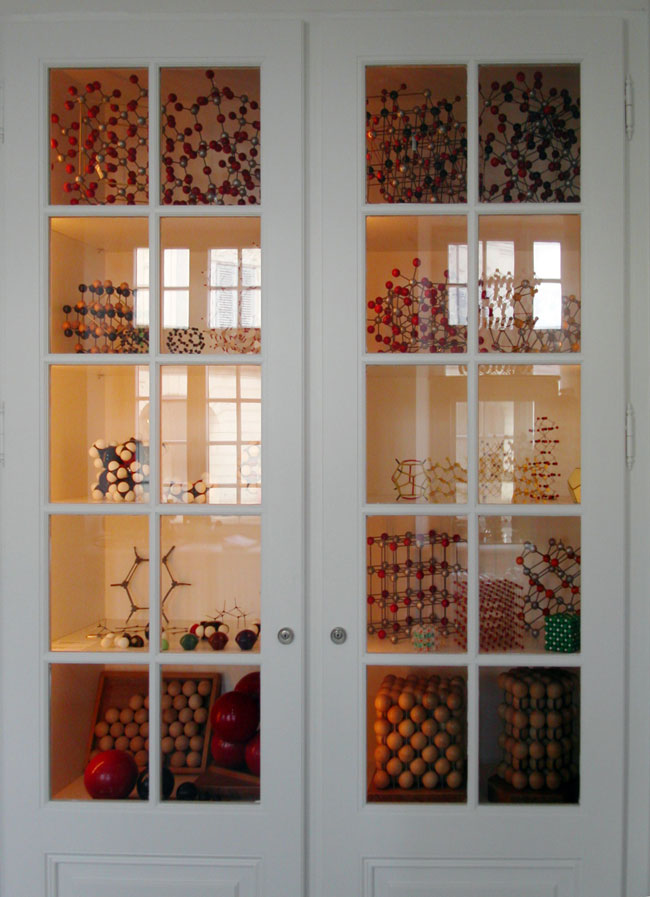
Examples of models for communicating from chemistry, crystallography, and materials science.
Exhibition view “Constructing Knowledge - Models and Model-Building in Chemistry”, Akademie Schloss Solitude Stutgart, May 13 - June 25, 2005. Photo: Anke Zürn 2005
|
| |
Models and Model-Building in Research / Modelle und Modellbau in der Forschung |
| |
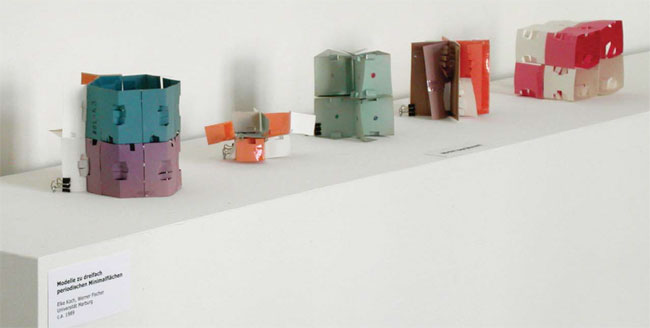
Models of periodic Minimal Surfaces, constructed to detect the genus of the surfaces (E. Koch, W. Fischer, University of Marburg, around 1989).
Modelle von periodischen Minimalflächen, gebaut zur Auffindung des Geschlechts der Flächen (E. Koch, W. Fischer, Universität Marburg, c.a. 1989).
Exhibition view “Constructing Knowledge - Models and Model-Building in Chemistry”, Akademie Schloss Solitude Stutgart, May 13 - June 25, 2005. Photo: Anke Zürn
|
| |
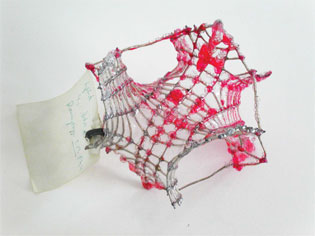
Model of a periodic Surface, constructed after a computer generated wire-frame model of an isosurface (research group H.G. von Schnering, MPI FKF Stuttgart).
Modell einer periodischen Fläche, konstruiert nach
computergenerierten “wireframe” Modellen von Isoflächen (Arbeitsgruppe H.G. von Schnering, MPI FKF Stuttgart).
Exhibition view “Constructing Knowledge - Models and Model-Building in Chemistry”, Akademie Schloss Solitude Stutgart, May 13 - June 25, 2005. Photo: Anke Zürn
|
|

Right: Model to detect water positions in a zeolite
(L. McCusker, ETH Zurich).
Left: Model to the nomenclature of fullerenes
(C. Thilgen, ETH Zurich).
Rechts: Modell zur Auffindung von Wasserpositionen in einem Zeolithen
(L. McCusker, ETH Zürich).
Links: Modell zur Nomenklatur von Fullerenen
(C. Thilgen, ETH Zürich).
Exhibition view “Constructing Knowledge - Models and Model-Building in Chemistry”, Akademie Schloss Solitude Stutgart, May 13 - June 25, 2005. Photo: Anke Zürn
|
| |
|
|
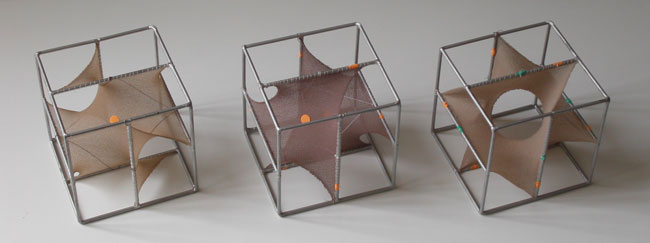
Models of periodic Minimal Surfaces with cubic symmetry (space group Ia3d), E. Koch, W. Fischer, University of Marburg.
Modelle von periodischen Minimalflächen mit kubischer Symmetrie (Raumgruppe Ia3d, E. Koch, W. Fischer, Universität Marburg.
Exhibition view “Constructing Knowledge - Models and Model-Building in Chemistry”, Akademie Schloss Solitude Stutgart, May 13 - June 25, 2005. Photo: Anke Zürn
|
| |
|
|
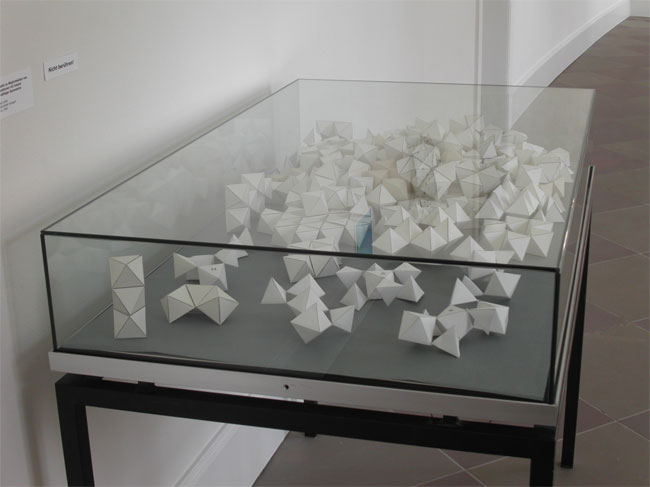
Paper models to possible crystal structure types.
Prof. Dr. Paul Keller, Institut für Mineralogie und Kristallchemie
Exhibition view “Constructing Knowledge - Models and Model-Building in Chemistry”, Akademie Schloss Solitude Stutgart, May 13 - June 25, 2005. Photo: Anke Zürn
|
| |
|
|
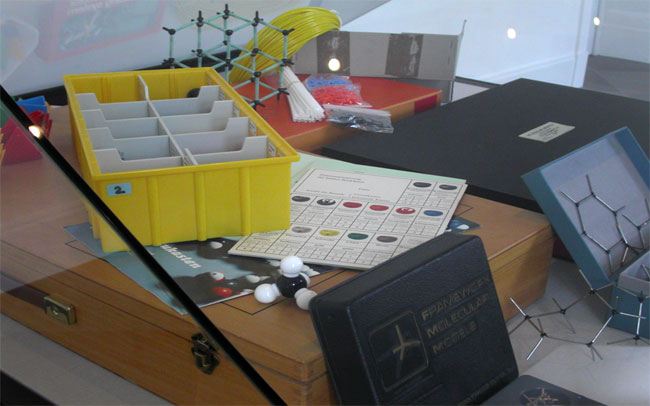
Exhibition view “Constructing Knowledge - Models and Model-Building in Chemistry”, Akademie Schloss Solitude Stutgart, May 13 - June 25, 2005. Photo: Anke Zürn
|
| |
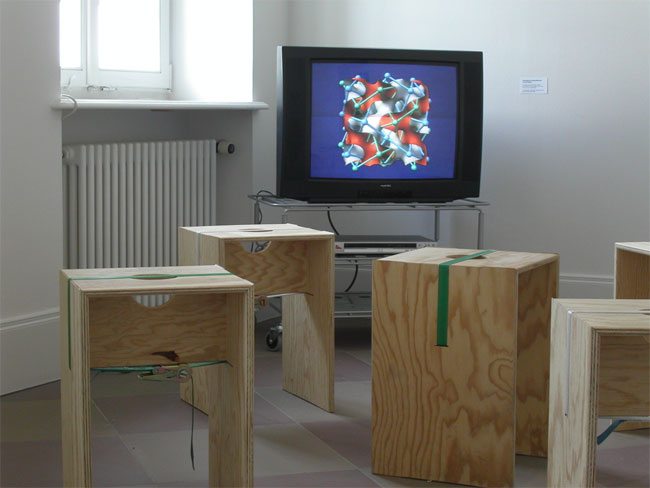
Exhibition view “Constructing Knowledge - Models and Model-Building in Chemistry”, Akademie Schloss Solitude Stutgart, May 13 - June 25, 2005. Photo: Anke Zürn
|
| |
|
|
Thanks / DankIch danke herzlich Herrn Prof. Dr. Reinhard Nesper und Herrn Jean-Baptiste Joly für ihre grossartige Unterstützung.
Mein besonderer Dank geht an folgende Personen und Institutionen, deren Leihgaben die Ausstellung erst ermöglicht haben:
|
| |
|
|
Universität Stuttgart:
Institut für Anorganische Chemie:
Prof. Dr. Gerd Becker
Prof. Dr. Thomas Schleid
Dr. Falk Lissner
Dr. Tanja Nikelski
Institut für Mineralogie und Kristallchemie:
Prof. Dr. Paul Keller,
Max-Planck-Institut für Festkörperforschung Stuttgart:
Prof. Dr. Dres. H. G. von Schnering
Universität Marburg, Mineralogie, Petrologie u. Kristallographie:
Prof. Dr. Werner Fischer
Prof. Dr. Elke Koch |
|
Eidgenössische Technische Hochschule Zürich:
Institut für Mineralogie und Petrographie:
Dr. Peter Brack,
Laboratorium für Physikalische Chemie:
Prof. Dr. Arthur Schweiger
Carlos Calle y Richter
Laboratorium für Organische Chemie:
Prof. Dr. François Diederich
Dr. Carlo Thilgen
Institut für Mikrobiologie:
Prof. Dr. Peter Dimroth
Dr. Thomas Meier
Laboratorium für Kristallographie:
Dr. Lynne McCusker
Laboratorium für Anorganische Chemie:
Prof. Dr. Reinhard Nesper
PD. Dr. Wolfram Uhlig
Institut für Molekularbiologie und Biophysik:
Dr. David Sargent |
| |
|
|
A special thanks to Helen, Nick, and Lu for helping me with the transportation of the models.
I will never forget the face of the customs officials, at the Swiss|German border, when we arrived with the right handed UK car packed full with strange models ( probably also it was not so clear, where the driver was sitting). Shortly after we arrived with the models from in Stuttgart Nick's car broke down. I still feel guilty.
A special thanks also to Tatsuto, who helped me so much to put everything up.
|